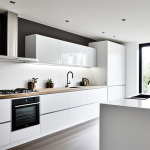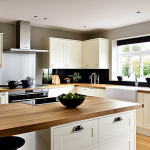Maximising Functionality in Small UK Kitchens
Designing a functional UK kitchen involves addressing common constraints like limited floor space, awkward room shapes, and older building layouts. These challenges demand creative, practical kitchen solutions that enhance usability without overcrowding.
To improve workflow in compact kitchens, prioritising a clear kitchen work triangle—linking the sink, stove, and refrigerator—is crucial. This reduces unnecessary movement. Incorporating space-saving kitchen ideas, such as pull-out countertops or vertical storage, can increase workspace without enlarging the footprint.
Also read : Is a Minimalist Approach to Kitchen Design the Secret to Smart Organization?
UK-specific trends emphasise integrating appliances into cabinetry for a seamless look, contributing to a tidy and efficient environment. Regulatory requirements, including ventilation standards and electrical safety, must be considered early to avoid costly adjustments. These rules also affect appliance choices and layouts.
Engaging with suppliers familiar with functional UK kitchen design helps ensure your remodel balances style, compliance, and day-to-day practicality. Adopting these actionable steps transforms even the smallest space into a kitchen that performs well and looks inviting.
Additional reading : How Can You Transform Your UK Kitchen to Enhance Slimness in Design?
Maximising Functionality in Small UK Kitchens
Creating a functional UK kitchen design within limited space requires careful consideration of typical UK kitchen constraints. Many British homes feature compact layouts, often narrow or irregularly shaped, which restrict movement and storage. To tackle these challenges, focusing on practical kitchen solutions such as efficient workflows and smart storage becomes essential.
Start by defining clear zones for cooking, cleaning, and preparation to improve kitchen usability. For example, positioning the sink, stove, and fridge in a triangle layout maximizes efficiency in tight spaces. Incorporating space-saving kitchen ideas like pull-out cupboards and corner carousels helps optimize every inch.
UK-specific trends also shape design choices. Contemporary small kitchens often use neutral tones and reflective surfaces to enlarge the visual space. Additionally, considering UK building regulations, such as minimum ventilation standards and electrical safety requirements, ensures safety without sacrificing space.
By combining careful spatial planning and adherence to regulations, you can design a compact kitchen that feels larger and works smarter. These practical kitchen solutions are key to transforming cramped UK kitchens into highly functional culinary hubs.
Smart Storage Solutions for Limited Kitchen Space
Creative kitchen storage solutions UK are vital when working with limited space. Built-in storage and concealed cabinetry seamlessly blend function and style, maximising available room while maintaining a tidy appearance. These features hide clutter effectively and support a streamlined kitchen environment.
Using vertical space is another key to space optimization. Installing shelves, hooks, and modular units turns walls into practical storage zones. Hooks can hold utensils or pots, while adjustable shelving adapts to various items’ sizes. This approach keeps counters clear, essential in small functional UK kitchen design.
UK-inspired storage innovations often incorporate multifunctional pieces, such as pull-out pantries or hidden compartments within cabinet doors. These ensure that every accessible inch serves a purpose, reflecting smart practical kitchen solutions common in compact UK homes.
The combination of concealed cabinetry with vertical storage not only increases capacity but also improves workflow by reducing clutter. Effective storage solutions transform limited kitchens into efficient, user-friendly spaces optimised for daily cooking and cleaning tasks.
Smart Storage Solutions for Limited Kitchen Space
Small UK kitchens benefit greatly from clever storage strategies that maximise every available inch. Built-in storage and concealed cabinetry are crucial kitchen storage solutions UK; they maintain a tidy appearance while optimising usability. Tall cupboards extending to the ceiling provide extra capacity without encroaching on floor space, ideal in compact layouts.
Vertical space is often underused but offers excellent potential. Installing shelves, hooks, or magnetic strips allows for accessible utensil storage and frees up counter areas. Modular units adaptable to changing needs further improve space optimization, enabling owners to customise storage according to their routines.
Innovative UK-inspired storage includes pull-out pantry units, integrated bin systems hidden behind cabinet doors, and corner carousel cupboards that turn awkward corners into practical storage zones. These practical kitchen solutions help maintain order and efficiency in small kitchens where clutter can quickly overwhelm functionality.
Incorporating these ideas ensures a more organised kitchen that supports daily cooking tasks, providing both convenience and style suitable to the unique constraints of UK homes.
Space-Saving Kitchen Layouts
Adopting the right kitchen layout ideas is vital for a functional UK kitchen design in small spaces. Commonly, galley and L-shape layouts are the most efficient for narrow or oddly shaped UK kitchens. These formats allow clear zoning for cooking, cleaning, and preparation, improving the workflow by reducing unnecessary movement.
Galley kitchens place work areas opposite each other, maximising use of limited floor space. L-shape designs open the room up and allow placement of dining or prep areas beside cooking zones. Open-plan adaptations are increasingly popular in UK homes, blending kitchen and living spaces for a more spacious feel.
When planning, consider UK-specific constraints like door swing space and plumbing placement, which influence layout feasibility. Using zoning techniques—separating cooking, cleaning, and storage—enhances usability and safety. For example, keeping the sink and dishwasher together near plumbing lines can save space and cost.
By focusing on space-saving kitchen ideas such as compact work triangles and carefully planned walkways, you create a practical kitchen solution tailored for everyday use. These layout choices maximise efficiency while addressing the common challenges of typical UK kitchen dimensions.
Maximising Functionality in Small UK Kitchens
Limited floor space and irregular layouts are hallmark challenges in functional UK kitchen design. To maximise usability, consider practical kitchen solutions that improve workflow while respecting spatial constraints. The classic kitchen work triangle—linking sink, stove, and fridge—remains vital in small kitchens, reducing unnecessary steps and boosting efficiency.
Space-saving kitchen ideas extend beyond appliance placement. For instance, integrating slimline or multifunctional appliances allows more room for preparation and storage without sacrificing style. Incorporating open shelving or pull-out drawers enhances accessibility, keeping key items within easy reach.
UK-specific regulations influence kitchen planning. Adequate ventilation, especially near cooking areas, must comply with local building codes to ensure safety and air quality. Electrical installation must follow standards that can affect appliance positioning and workspace layout.
Adapting floor plans to fit typical UK home quirks, such as narrow corridors or unusual wall angles, is another practical kitchen solution. Tailoring layouts to these features prevents wasted space and promotes seamless movement.
Together, these steps create kitchens that balance practical efficiency with aesthetic appeal, enabling even the smallest UK kitchen to function as a well-organised, comfortable cooking space.
Maximising Functionality in Small UK Kitchens
Addressing limited space in a functional UK kitchen design requires strategic interventions that prioritise usability and compliance with local norms. Common challenges include narrow layouts and outdated utility placements, which restrict movement and storage options. To boost efficiency, focus on streamlining workflow by designing clear zones for preparation, cooking, and cleaning. Aligning these areas within proximity not only enhances practicality but also saves time during meal preparation.
Implementing space-saving kitchen ideas plays a crucial role. Consider incorporating foldaway or extendable surfaces to temporarily expand workspace without permanent encroachment. Using compact or multi-use appliances further frees room while maintaining full functionality.
UK-specific regulatory considerations, such as ventilation requirements and electrical safety standards, influence design decisions profoundly. Early engagement with these regulations ensures your kitchen remodel meets legal thresholds without compromising space or style.
Practical kitchen solutions also include integrating accessible storage close to workstations, reducing clutter and promoting order. By combining thoughtful spatial planning, adherence to UK building codes, and flexible design elements, small kitchens can transform into highly efficient and pleasant environments tailored to everyday needs. This approach maximises limited floor space while delivering functional benefits essential to British homes.
Maximising Functionality in Small UK Kitchens
Small UK kitchens face distinctive challenges such as limited floor area, narrow or irregular shapes, and older building quirks. To create a functional UK kitchen design within these restrictions, embracing practical kitchen solutions that streamline workflow is essential. Efficient use of the classic work triangle—linking sink, stove, and fridge—is a foundational step, reducing unnecessary steps and boosting usability.
Beyond layout, space-saving kitchen ideas include choosing slimline or integrated appliances that free up crucial counter and storage space. These appliances are designed to fit compact areas while maintaining functionality, supporting a tidy and efficient environment.
Planning must also respect UK-specific regulatory considerations. Building codes require proper ventilation near cooking zones to ensure safety and indoor air quality. Electrical regulations dictate appliance placement, limiting certain configurations but guiding safer kitchen design. Accounting for these regulations early prevents costly modifications later.
Additionally, adapting designs to accommodate narrow corridors or unusual wall angles typical in UK homes turns spatial challenges into opportunities. Customising cabinetry or work surfaces around these features creates seamless, ergonomic spaces.
Together, these measures enable a highly functional UK kitchen design that balances compliance, efficiency, and everyday practicality in small spaces.
Maximising Functionality in Small UK Kitchens
Designing a functional UK kitchen design in limited space demands addressing typical constraints such as narrow layouts, irregular shapes, and older utility placements common in British homes. These challenges call for practical kitchen solutions that optimise every inch without compromising usability or style.
An effective strategy is to improve workflow by defining clear zones for cooking, cleaning, and preparation. This zoning approach, combined with a well-planned kitchen work triangle, reduces inefficient movement. Introducing space-saving kitchen ideas like foldaway counters or extendable worktops temporarily expands surface area while maintaining openness when not in use.
In the UK, adherence to building regulations significantly shapes design choices. For instance, ventilation requirements around cookers ensure air quality and safety, influencing appliance positioning. Electrical safety standards also determine layout aspects, including socket placement and appliance spacing to prevent hazards.
Moreover, selecting compact or multifunctional appliances further frees up valuable counter and storage space, aligning with both practical needs and modern British kitchen trends. Altogether, focusing on well-coordinated zoning, regulatory compliance, and adaptable furniture creates small kitchens that are highly functional, safe, and visually appealing.
Maximising Functionality in Small UK Kitchens
Small UK kitchens confront challenges such as limited floor space, narrow layouts, and unusual architectural features. Addressing these issues requires practical kitchen solutions focused on improving workflow and usability without compromising style or compliance.
A fundamental step is to optimise the kitchen work triangle. Ensuring the sink, stove, and fridge are placed in close, unobstructed proximity reduces movement, maximising efficiency in tight areas. Alongside layout considerations, adopting space-saving kitchen ideas like slimline appliances and pull-out work surfaces expands usability without crowding.
Workflow improvements also stem from zoning—clearly defining areas for cooking, preparation, and cleaning. This separation promotes order and safe navigation. Incorporating integrated storage near workstations keeps essentials accessible, minimising clutter.
UK-specific regulations influence design choices, particularly ventilation near cooking zones and electrical safety standards. Complying with these rules is essential to ensure both safety and functional space planning. Early consideration avoids costly retrofits.
Additionally, neutral palettes and reflective surfaces, popular trends in functional UK kitchen design, visually enlarge rooms and create an inviting atmosphere. Through combining thoughtful workflow, regulatory adherence, and clever space-saving strategies, small UK kitchens become efficient, practical environments tailored to everyday needs.
Maximising Functionality in Small UK Kitchens
Limited space, irregular shapes, and older building layouts pose significant challenges in a functional UK kitchen design. Overcoming these constraints requires targeted practical kitchen solutions that streamline workflow while enhancing usability.
Improving workflow begins with establishing clearly defined zones for cooking, cleaning, and preparation. Aligning these zones within a compact yet efficient kitchen work triangle reduces unnecessary movement, saving time and effort during meal preparation. Incorporating space-saving kitchen ideas such as foldaway work surfaces or sliding drawers increases usable workspace without crowding the room.
UK-specific regulations must be factored into design plans early. Ventilation standards around cooking appliances ensure safety and air quality, while electrical safety requirements influence appliance positioning and socket placement. Compliance with these rules avoids costly remodeling and guarantees a kitchen that functions safely and effectively.
To maximise floor space, choosing compact or integrated appliances following UK style trends enhances practicality without sacrificing aesthetics. Moreover, bespoke cabinetry that fits awkward wall angles or narrow corridors common in UK homes transforms spatial challenges into usable storage or workspace.
By combining zoning techniques, regulatory compliance, and clever furnishings, these practical kitchen solutions create functional UK kitchen designs that maximise efficiency within minimal space.



